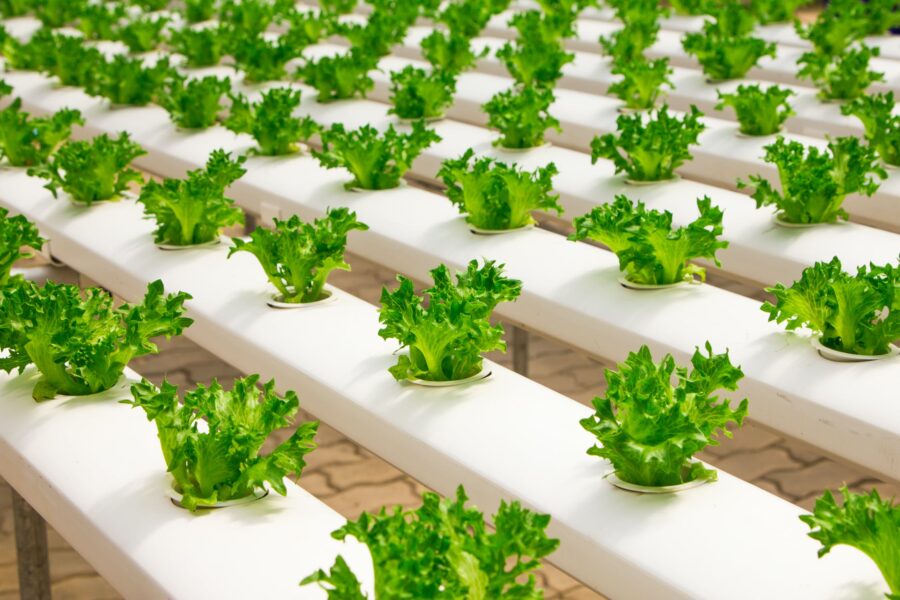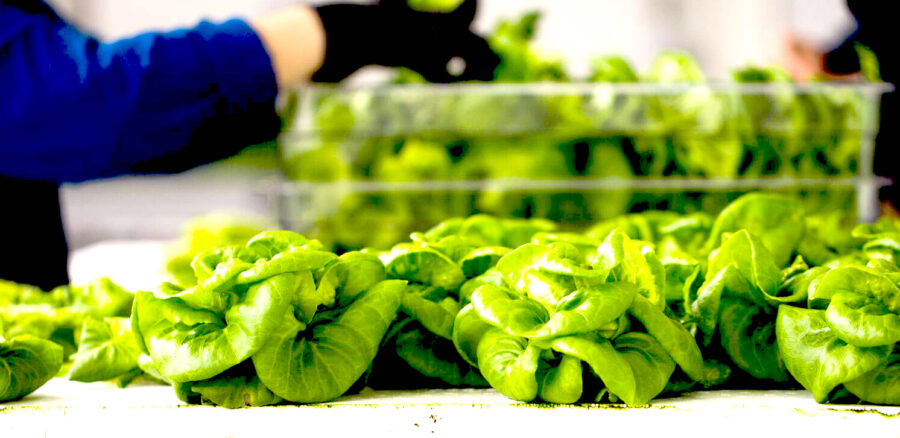What is Vertical Farming?
Going up! Controlled Environmental Agriculture (CEA), more commonly known as Vertical Farming, is taking the agriculture industry by storm. This innovative farming technique functions as a sustainable source of food generation. Vertical Farming takes the process of growing food and crops to a factory-like production style. In a controlled indoor environment, plants are stacked vertically as tall as 8 feet high. Carbon dioxide, light, humidity, and temperature are all controlled and monitored closely within these environments. A primary goal of Vertical Farming is to create more crops while using the same amount of space, if not less. Not only does Vertical Farming use less space and water than traditional farming but it also reduces the amount of soil used as well.
Currently, there are three methods of Vertical Farming: hydroponics, aeroponics, and aquaponics. Hydroponics uses the nutrient solution which gets pumped around the base of where the plant roots grow directly into. In aeroponics, on the other hand, the plant roots grow freely, while a mist of water and nutrients is sprayed directly onto them. The last method, aquaponics, is generally a combination of hydroponics and aeroponics. All three methods are often utilized on vertical farms and draw information, technique, and results from one another.
How does it work?
Vertical Farming allows producers to have 24/7 control and oversight of the crops 365 days a year. The constant monitoring of Vertical Farming provides useful information to those who will consume the product. To increase Food Safety controls, vertical farmers often keep a record of the details of different crops including, the times the crop was watered, fed, and the transportation and packaging details of the product. Producers closely monitor all elements in the environment to ensure crops have optimal growth potential. Vertical Farming started with the production of lots of leafy greens and herbs and is continuing to grow and produce bigger crops such as tomatoes, bell peppers, and cucumbers.
Vertical Farming will often employ the use of semi-automated conveyors which carry bins full of crops around the designated farming area. These bins are moved within the vertical farm location depending on where they are at in their growth cycle. These conveyors are a crucial component of vertical farming, as they allow for easy access to these tall stacks of crops. An automated Vertical Farming system has the potential to customize crop pathways within the conveyors. Currently, the use of manual conveyors is popular in Vertical Farming. With the growth of Vertical Farming techniques and operations, automated conveyors offer a method of increased efficiency and effectiveness.
What are the benefits?
Vertical Farming offers many benefits to all those involved. Vertical Farming eliminates the threat of pests, diseases, and contaminants such as pesticides, synthetic fertilizers, herbicides, and air pollution. Vertical farms also use 95% less water than traditional farms and takes advantage of recycled water systems. The water drips down from the top of the crop stacks all the way down to the bottom then returns to the top on a continuous loop. Since agriculture is responsible for almost 70% of fresh water available for human use this reduction of water use is helping control major environmental and health crisis issues.
Some basic benefits of vertical farming include:
-
-
- Easily integrated into urban areas
- More crops planted in less area
- Utilization of empty space above
-
Vertical Farming also reduces the risk of occupational hazards. Rather than having farmers work hours on end in harsh conditions vertical farm producers have the luxury of monitoring crops without enduring outdoor weather conditions; they also monitor crops via camera. In addition to the less severe working conditions, vertical farm producers avoid the risk of potentially being exposed to disease and chemicals associated with traditional farm products. Many traditional farming products such as fertilizers require safety training and exceeded inhalation could cause health issues. Vertical Farming avoids these risks by modifying the farming process and replacing these harsh chemicals with a less threatening substitute.
Lastly, and perhaps the greatest benefit to Vertical Farming, is that crops and food can continue to grow all year long rather than just in season. Ideally, growing and offering these crops all year long will also help to combat the rise in prices for a seasonal product. If fresh products are offered year-round, there should be no seasonal surge prices. Additionally, crops are protected from natural hazards such as heavy rains, heavy winds, or tornados which could negatively impact their growth. In turn, Vertical Farming can greatly contribute to the food generation crisis which is of rising concern. These are just a few of the many benefits of Vertical Farming. The concept of Vertical Farming is still a relatively new method, there are many more advantages to explore.
The Future of Farming & Food Production
Vertical Farming makes accessing fresh food easier than ever, it is both consumer and producer friendly. With traditional farming, only those within a close distance to the farming fields could truly enjoy the fresh crops. Vertical Farming allows everyone, no matter where you are located to enjoy fresh and highly nutritious food. As populations continue to rise, Vertical Farming offers a solution to help aid the rising concern of food generation. By making fresh food more assessable and generating larger quantities of crops Vertical Farming will have a strong effect on the food production industry. Vertical Farming has the potential to influence other food production operations to consider a more effective way to utilize space and to increase production.
Vertical Farming is in no way taking over tradition al farming. While Vertical Farming has been gaining more and more attention from the public, traditional farming will always be necessary. Virtual Farming offers an alternative method to traditional farming; it is meant to enhance the existing agricultural industry not to take over the industry. Vertical Farming and traditional farming will continue to grow the amounts of fresh food produced to the population working together to help ensure all humans have access to these nourishing products.
al farming. While Vertical Farming has been gaining more and more attention from the public, traditional farming will always be necessary. Virtual Farming offers an alternative method to traditional farming; it is meant to enhance the existing agricultural industry not to take over the industry. Vertical Farming and traditional farming will continue to grow the amounts of fresh food produced to the population working together to help ensure all humans have access to these nourishing products.
Going forward we can expect to see more experimentation and increased popularity of Vertical Farming. As techniques become more and more refined, the opportunities for Vertical Farming will continue to grow.
Here’s to going up!
The Tri-Mach Advantage
From complex automated processing systems involved in Vertical Farming to vertical conveyor lines, we’ve designed, built, and installed it all. Our expert consultants have worked with some of the largest vertical processors in North America, creating custom processes to meet their specific operations. The result is an unmatched experience and final product which is guaranteed to take your farming to the next level.
Looking to learn more about vertical farming or how Tri-Mach can improve your vertical process? Give us a shout here!
